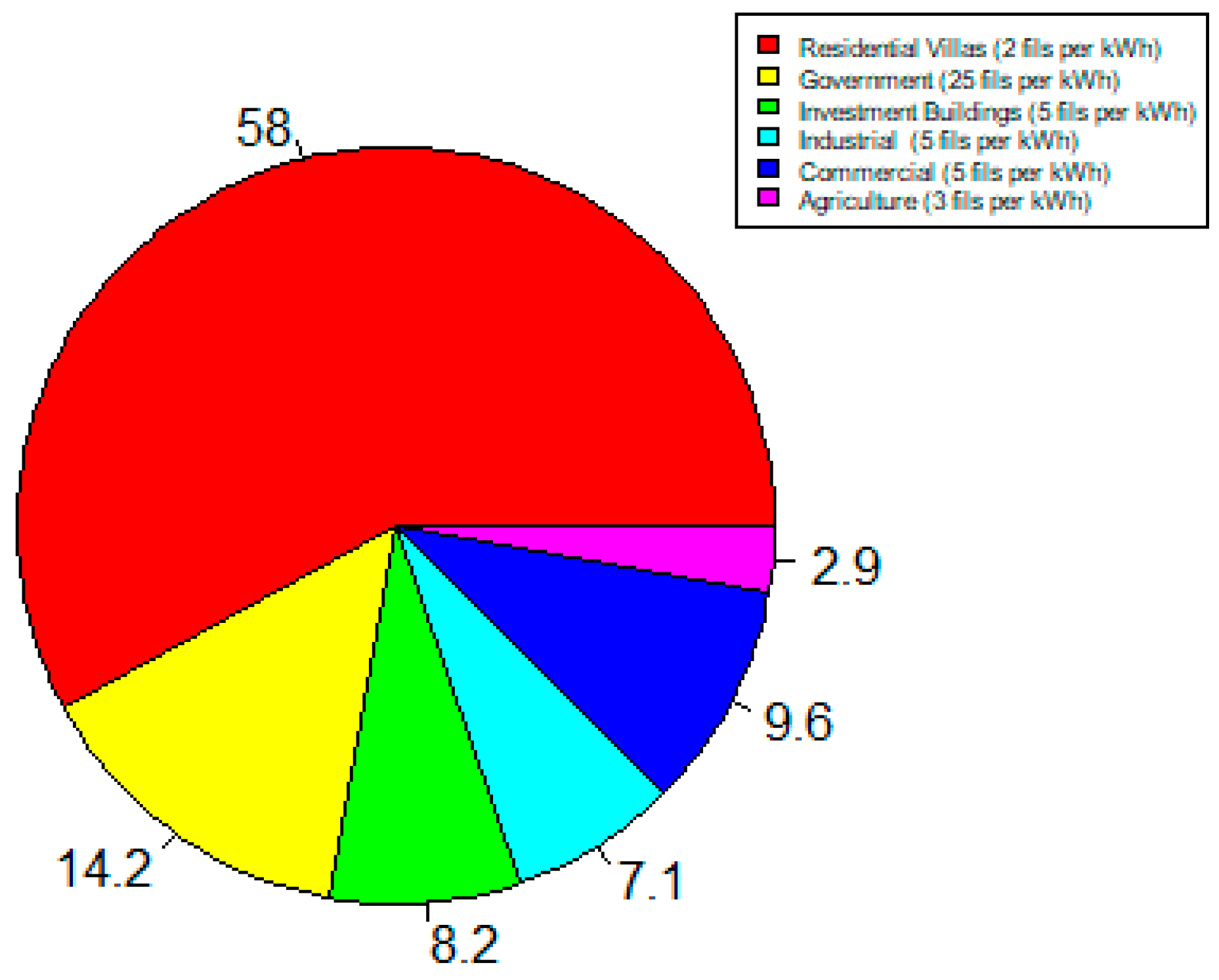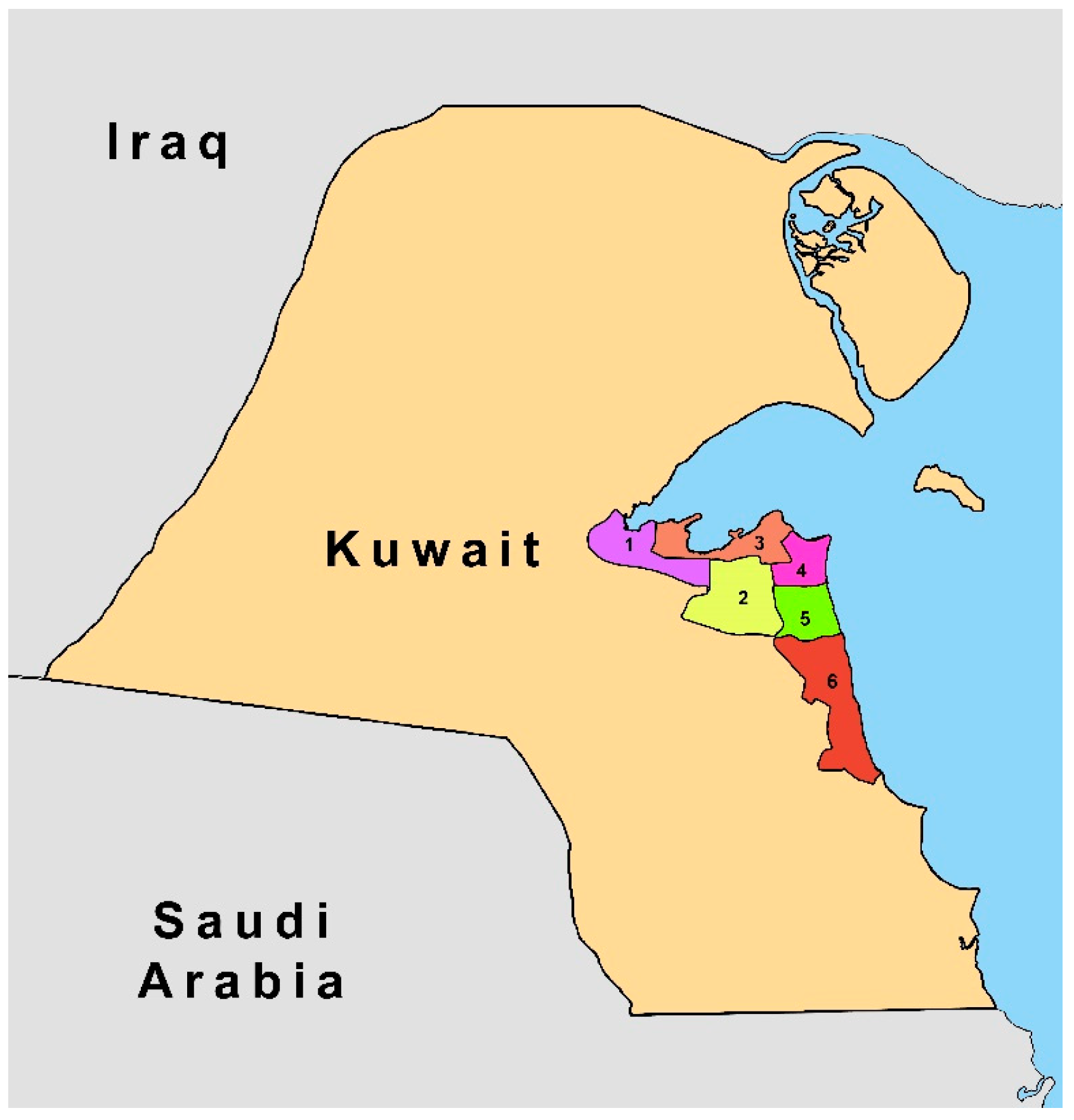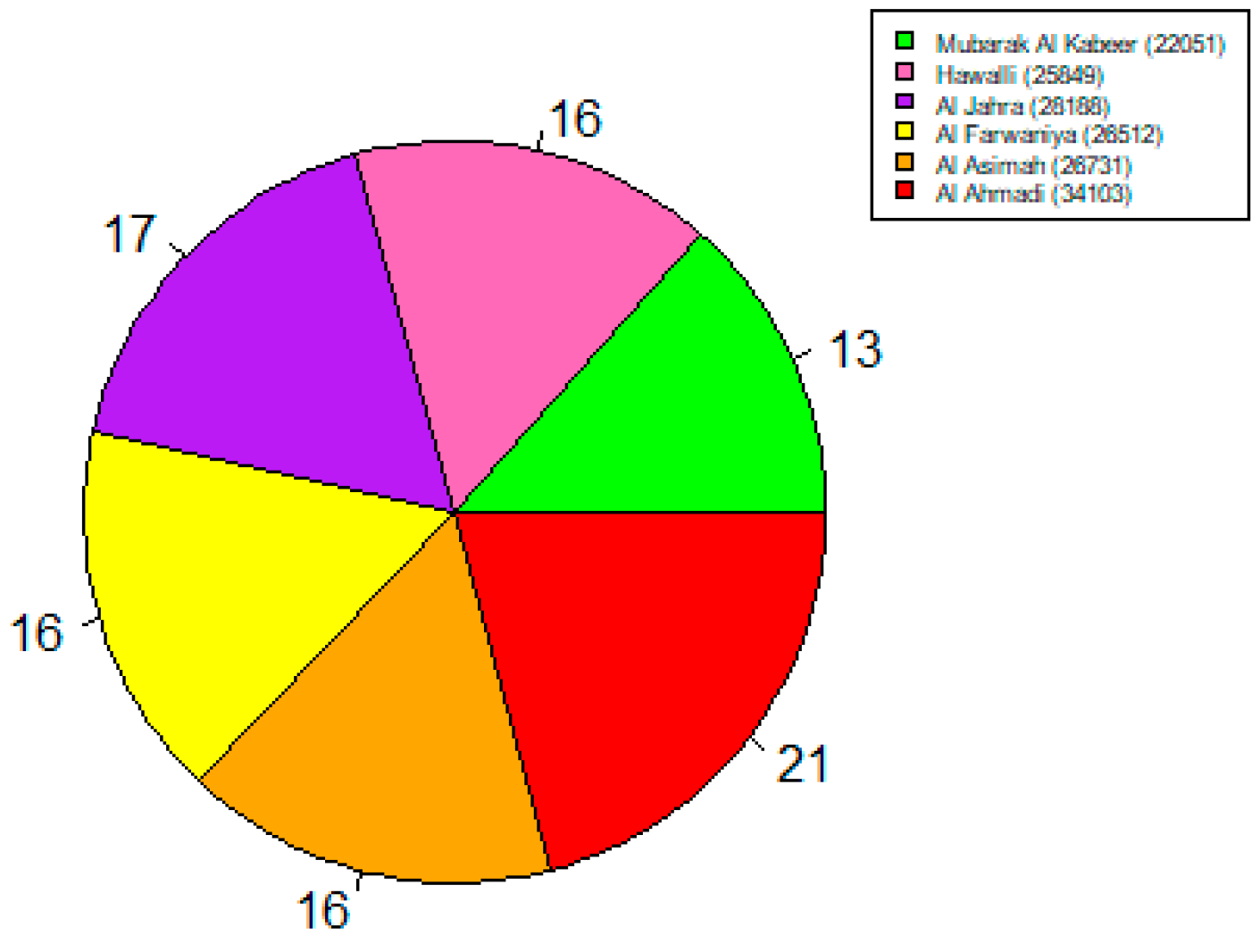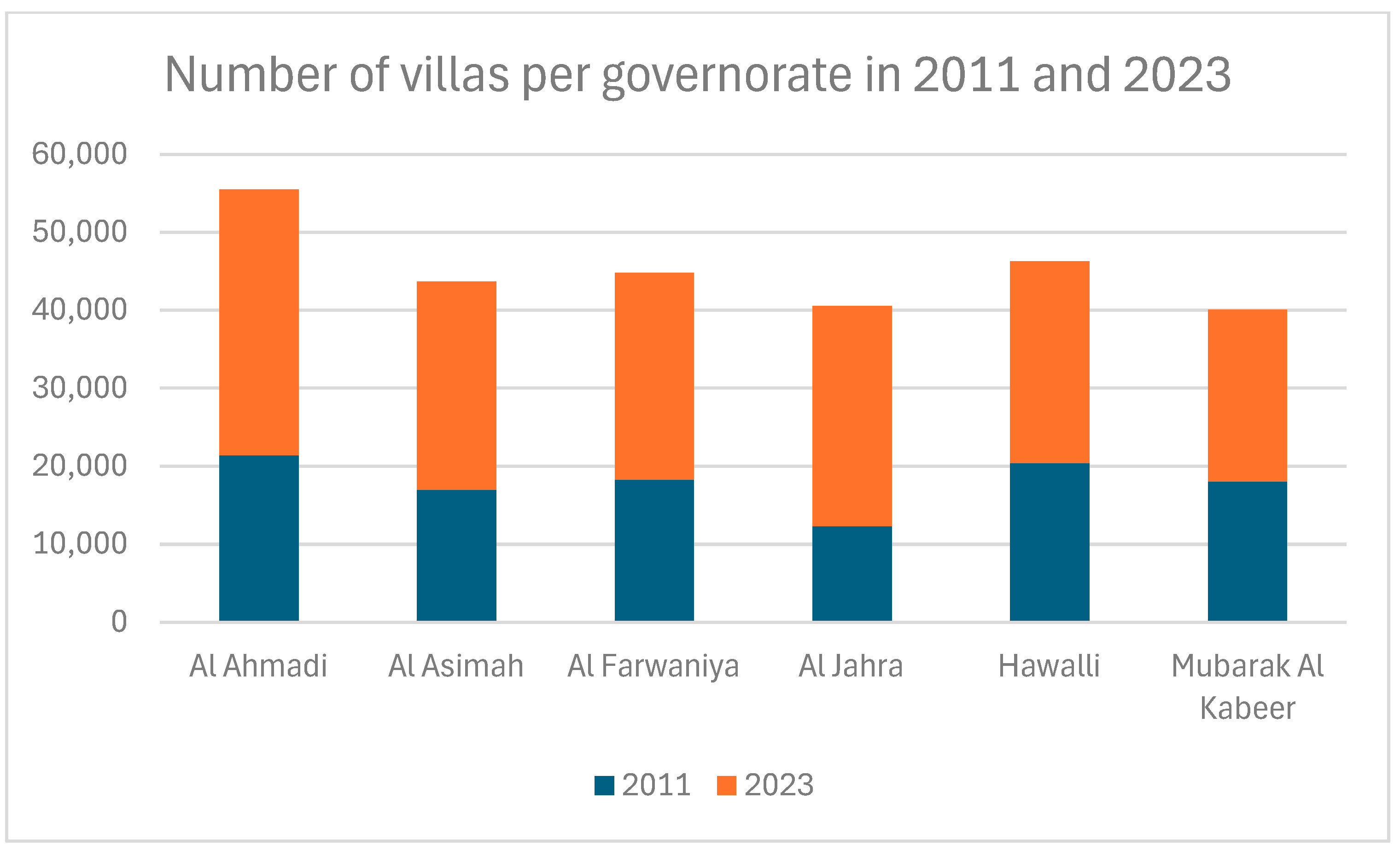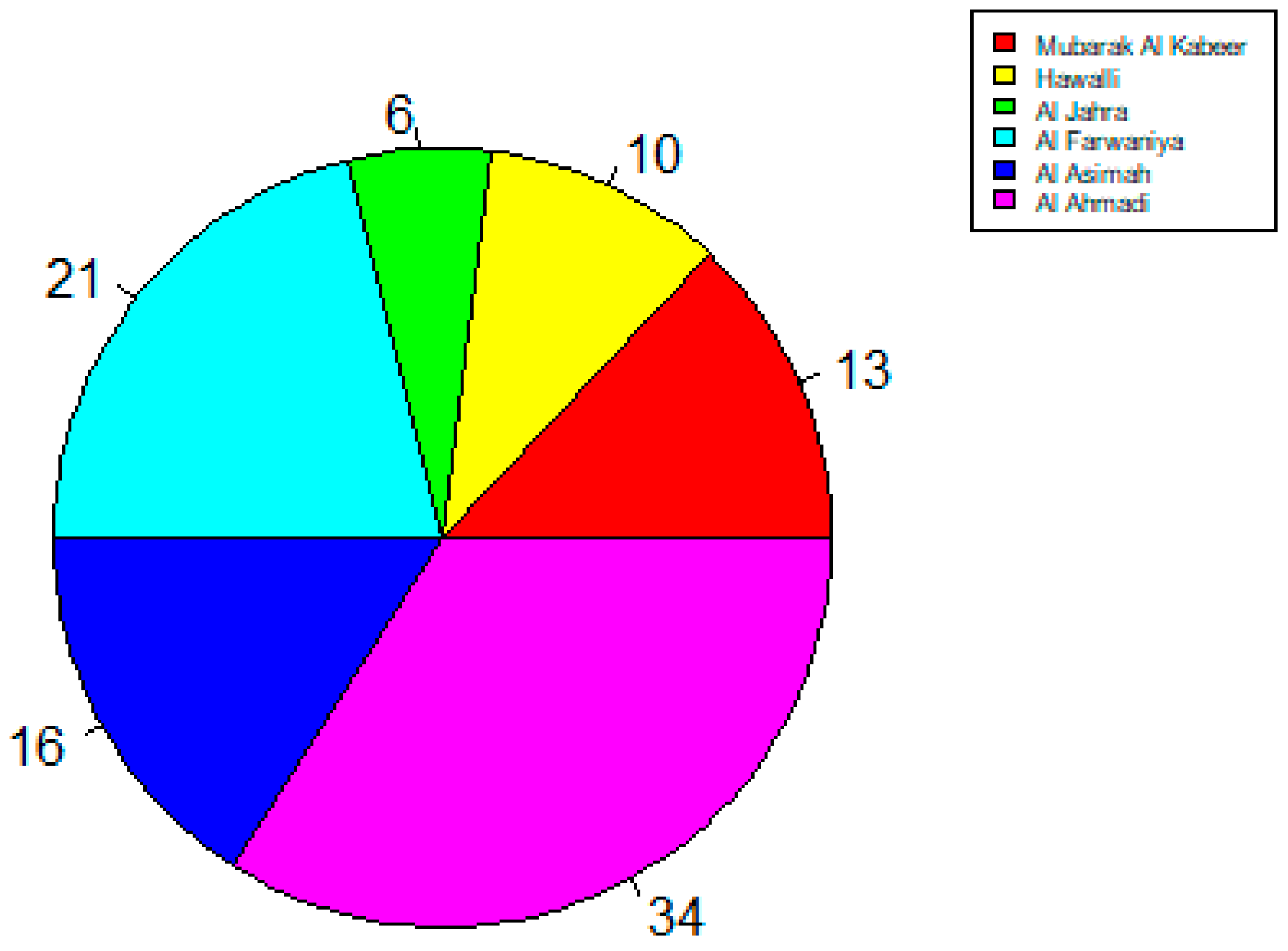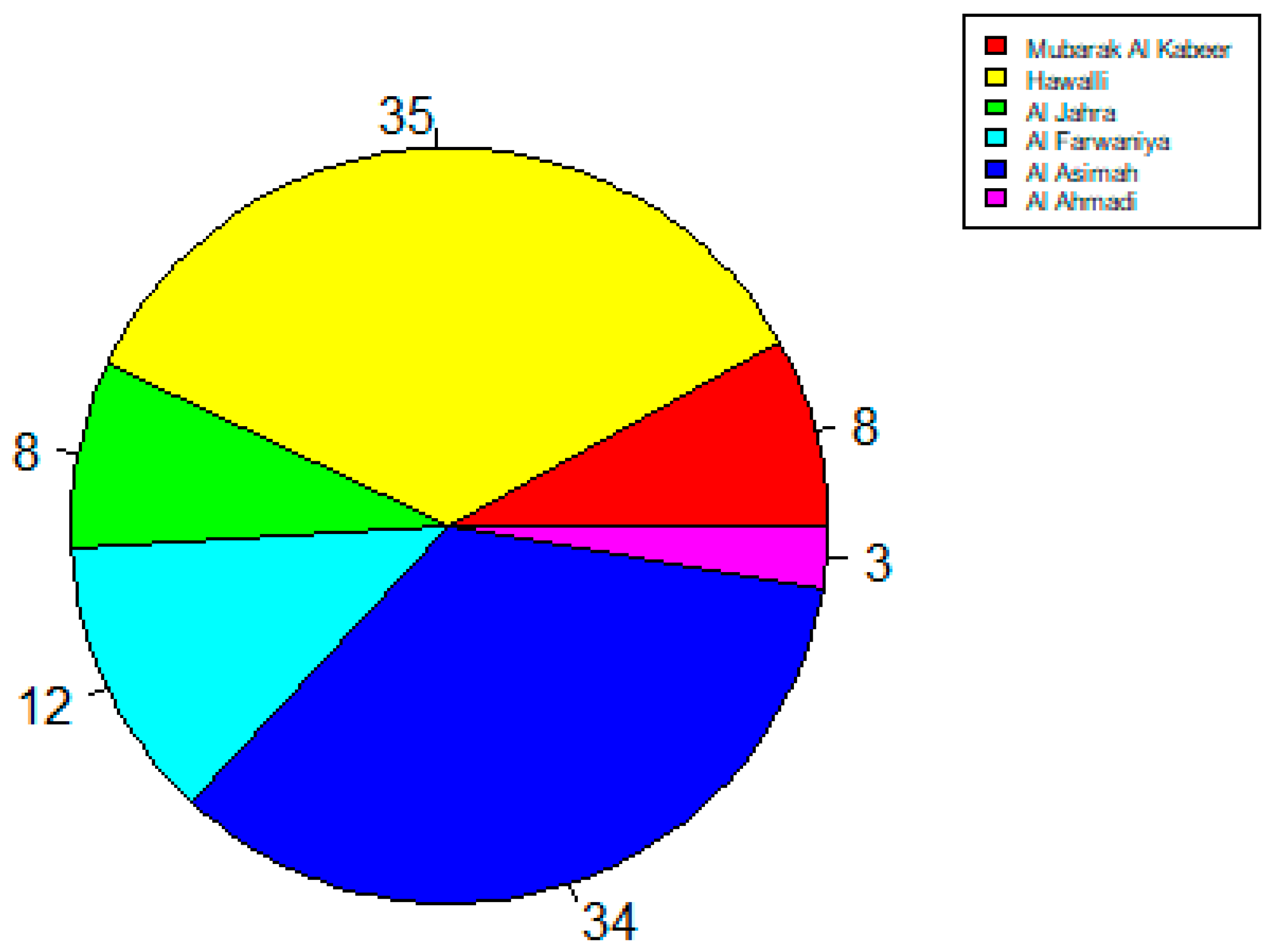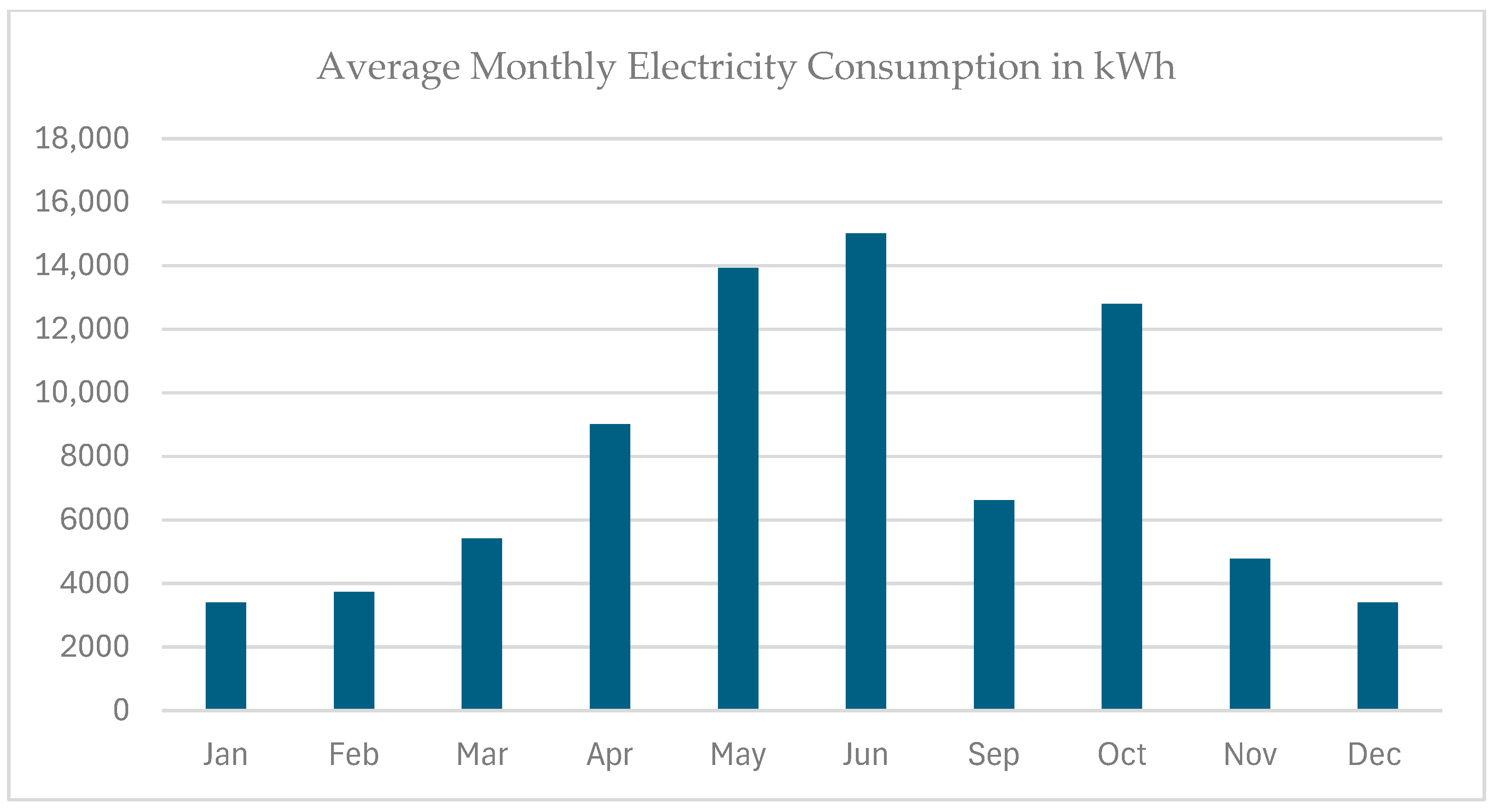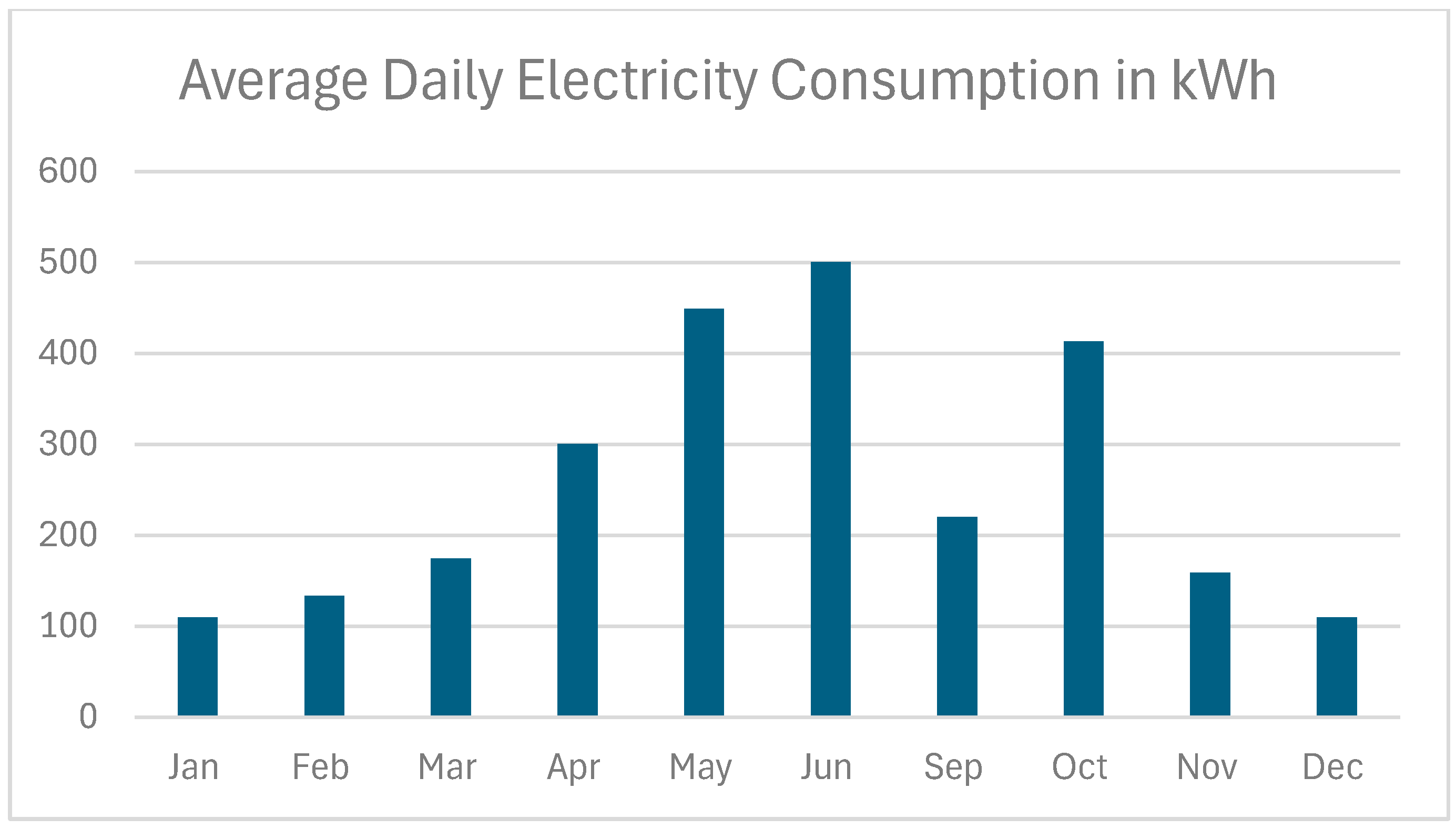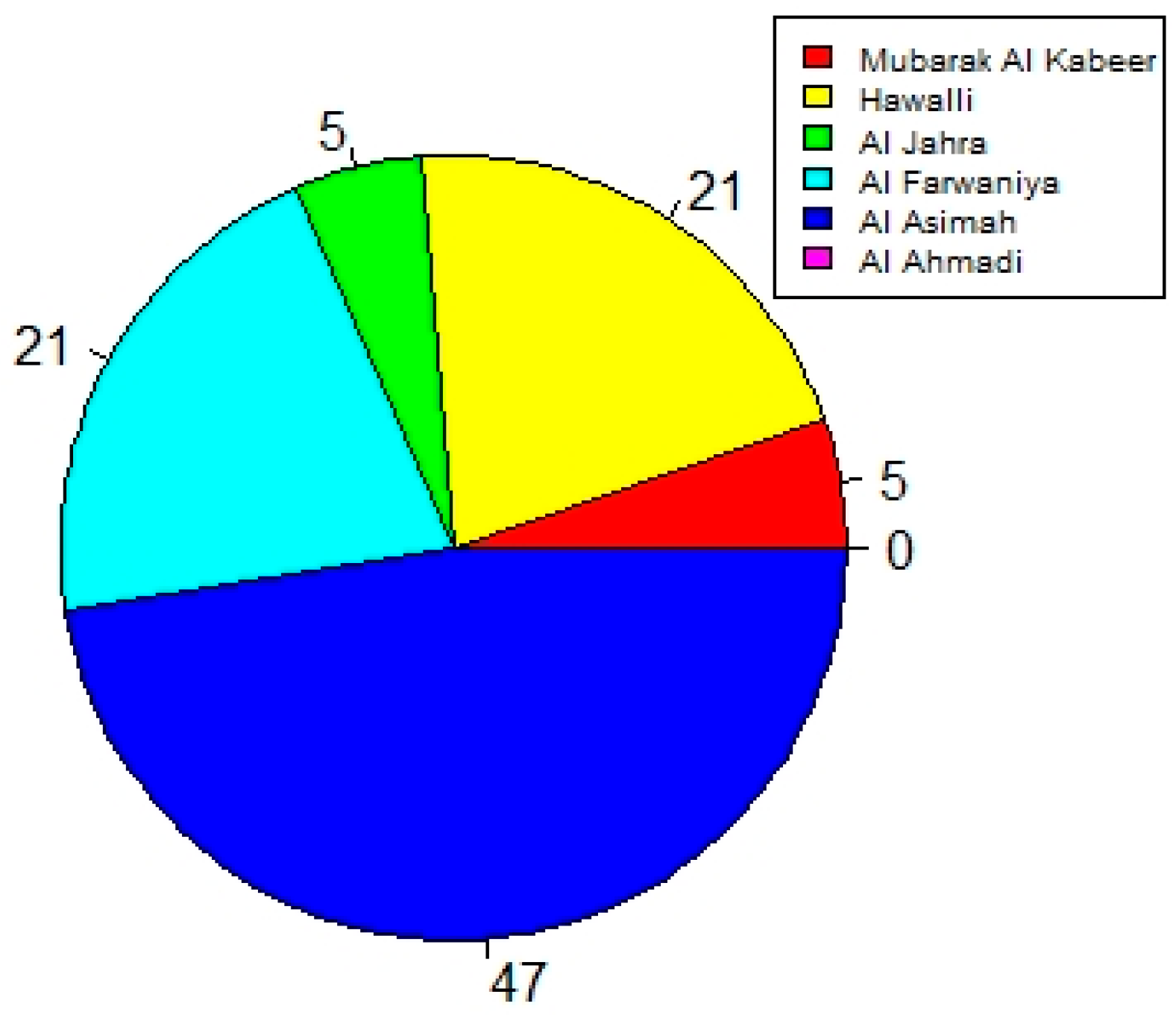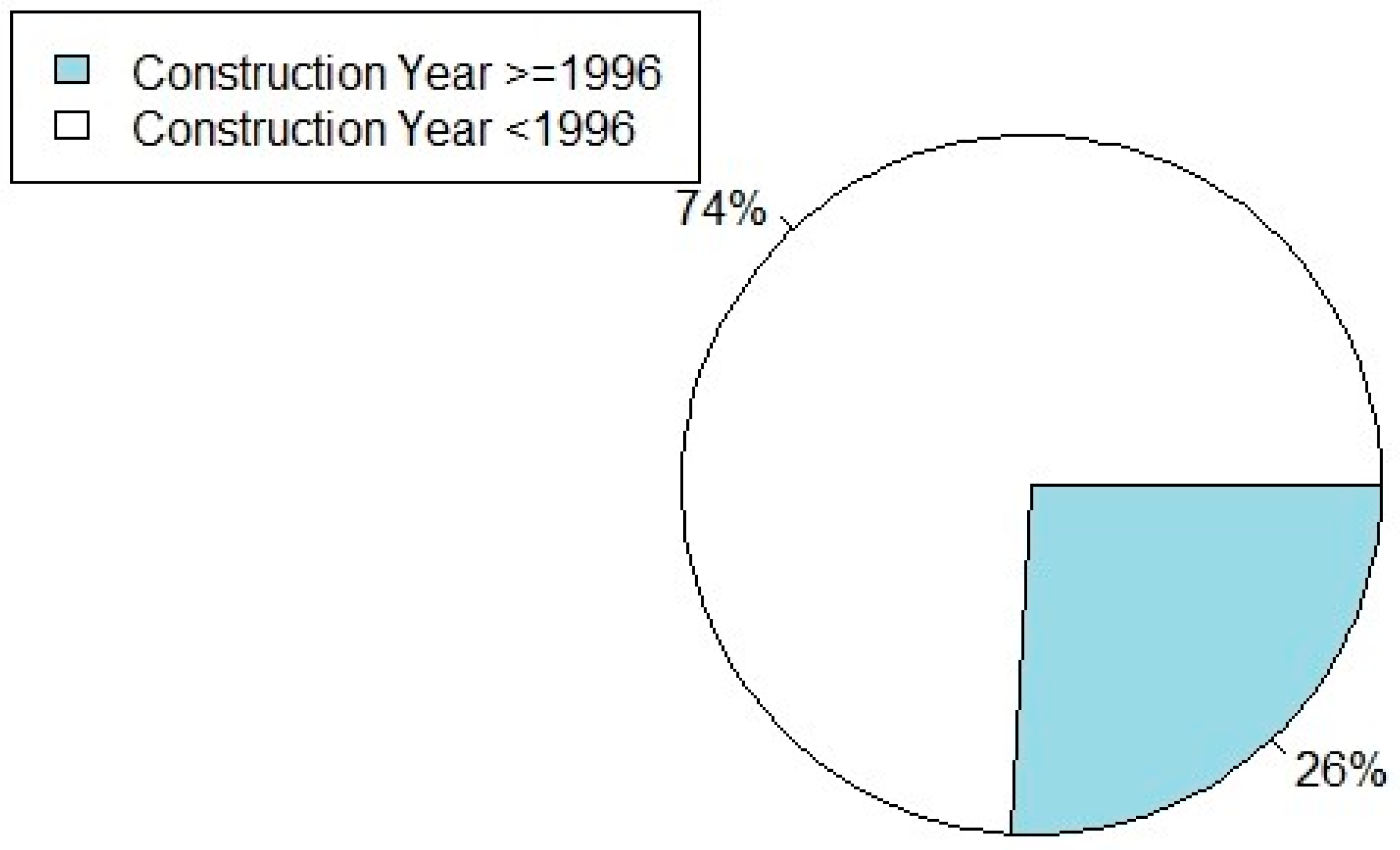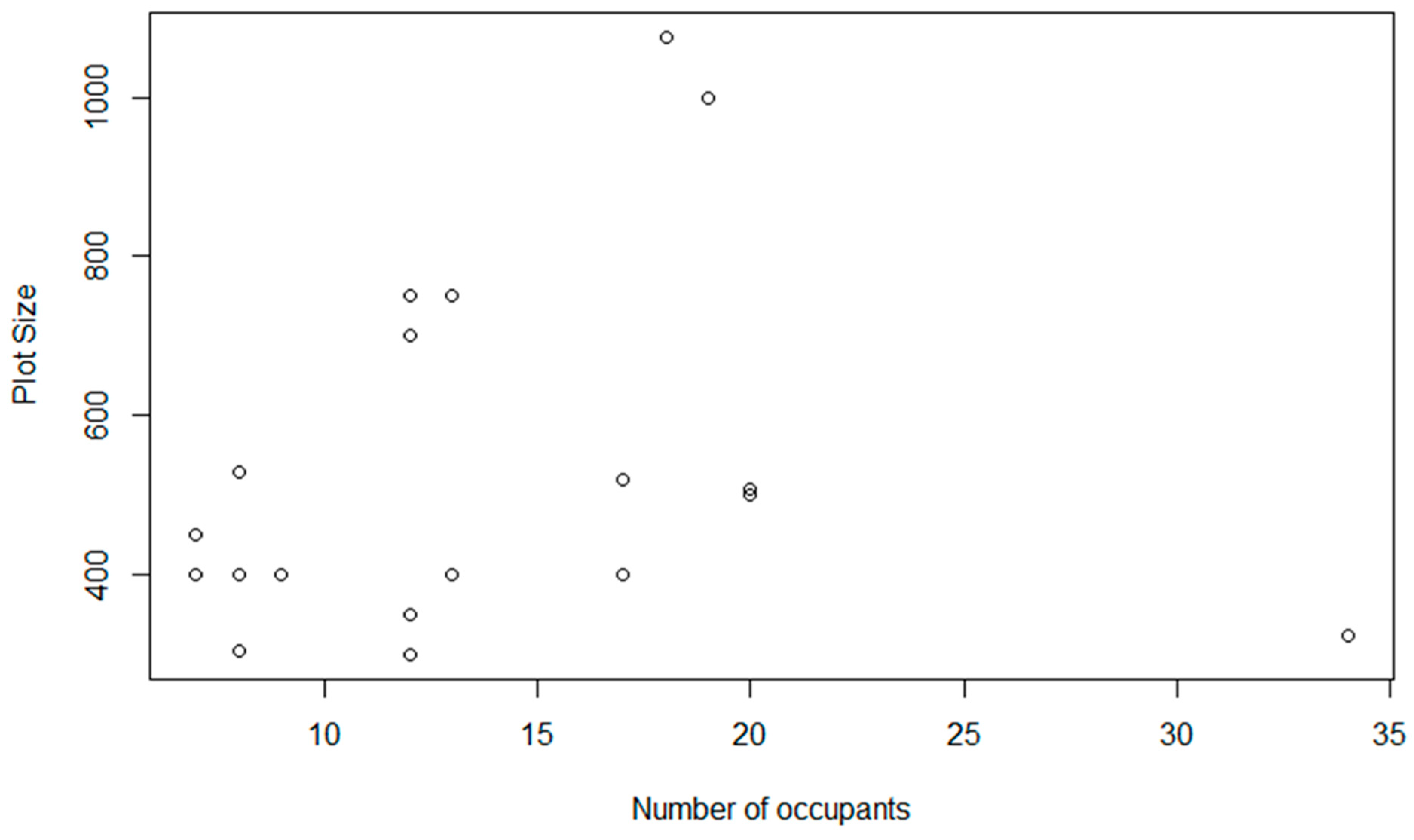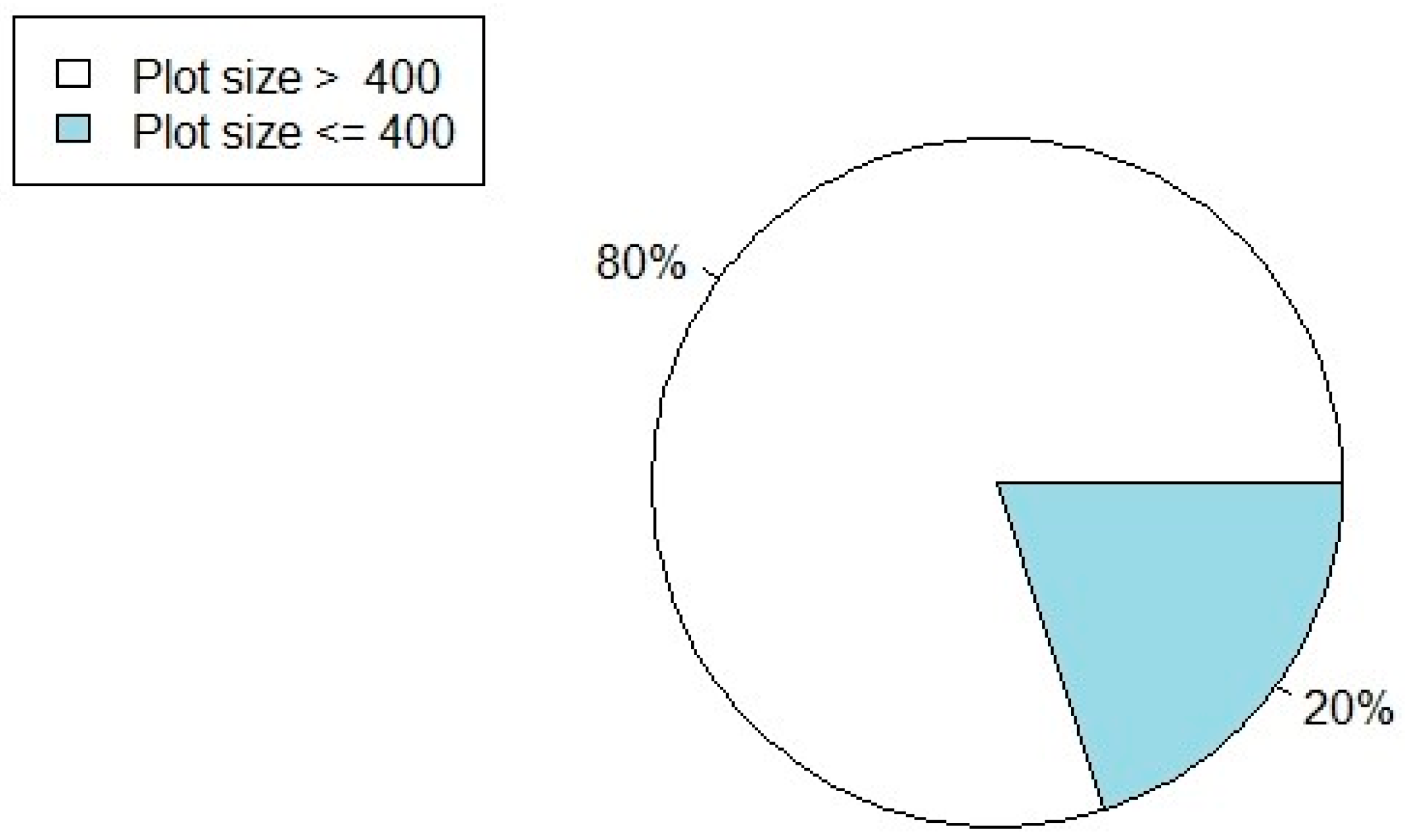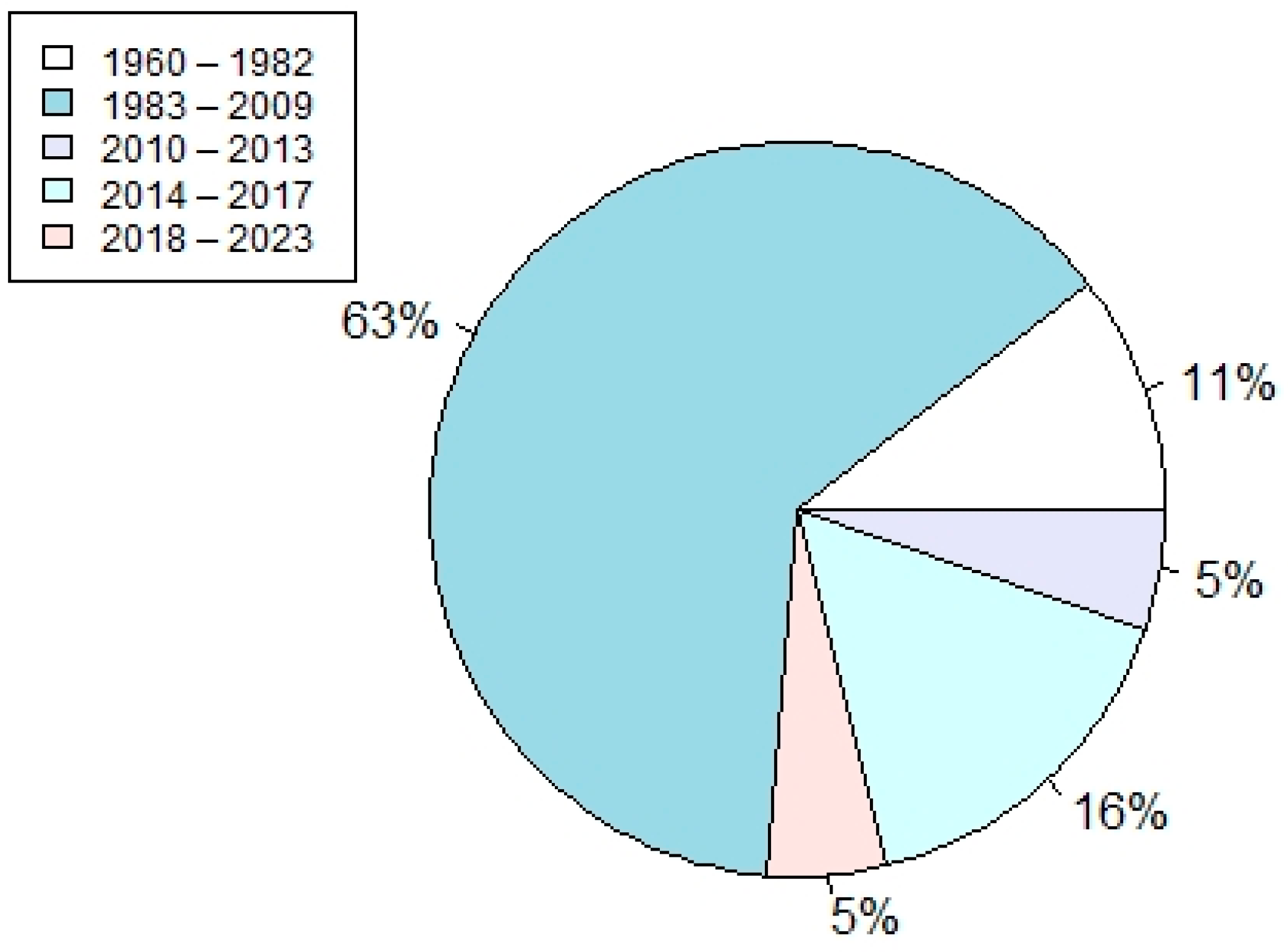Kuwait is a hot and arid country situated on the northern tip of the Arabian Gulf, bordering the Kingdom of Saudi Arabia and Iraq. It has a total area of 17,399 km
2 and a population of 4,918,570 [
1]. Kuwait’s economy is controlled by its oil and gas industry, with many of its resources being utilized to meet the energy needs of its population. Kuwait is ranked among the countries with the highest residential electricity consumption per capita and the highest electricity subsidies per capita when compared to other Gulf Cooperation Countries, such as Qatar, Bahrain, and the Kingdom of Saudi Arabia [
2] (p. 30). Furthermore, Kuwait has the highest level of carbon dioxide-equivalent emissions per capita in the world, with a value of 21 tons/capita; these emissions are predicted to increase by 2035, with an average annual growth of 1.1% [
3]. The high energy consumption per capita is due to the following three main factors: (1) the increasing residential demand for electricity to operate mechanical cooling systems, (2) the reliance of most of the population on the use of private cars for transport, and (3) the high energy subsidies for producing electricity and oil products [
3] (p. 46).
1.1. High Electricity Consumption in Kuwaiti Villas
In the early 1980s, the Kuwait Ministry of Electricity, Water, and Renewable Energy (MEWRE) recognized the importance of reducing electricity consumption in the building sector. Because electricity is used for cooling, heating, lighting, appliances, and water heating in Kuwaiti homes, referred to as villas, the term “energy” in this paper refers to electricity, even though many Kuwaiti villas use gas in the form of butane/propane 12Kg cylinders and/or electric ovens and stoves for cooking [
5]. As Kuwait’s population has increased, more residential villas have been built to meet the growing demand for housing, resulting in an increase in electricity demand and consumption for cooling. Consequently, in 1983, the MEWRE commissioned the Kuwait Institute for Scientific Research (KISR) to develop a code for the purpose of improving the energy efficiency of buildings in Kuwait. The KISR developed the first edition of the Energy Conservation Code of Practice for Buildings (ECCPB) in 1983, and it went through subsequent revisions in 2010, 2014, and 2018 [
6]. The code provides the minimum energy requirements for the design and construction of various building types in Kuwait, including residential villas. These energy requirements include power density for air conditioning (A/C) and lighting systems, building material insulation, glazing characteristics for windows and curtain walls, window-to-wall ratios, building envelope air infiltration, and thermostat requirements [
6].
With the aid of energy modeling simulation, researchers at KISR predicted a 40% reduction in the cooling loads for buildings constructed in full compliance with the 1983 ECCPB code [
7] (p. 99). However, there is little evidence of the effectiveness of the code in practice [
8], and despite the three updated versions of the ECCPB code, Kuwait’s residential building sector’s demand for electricity has continued to increase over the years [
9]. In 2019, the buildings and transport sectors had the largest share of energy demand in Kuwait. To develop effective strategies for reducing energy consumption, the KISR published the first edition of the Kuwait Energy Outlook (KEO) in 2019. This publication provided an overview of energy demand trends in Kuwait based on reliable data, as well as robust projections that serve as a foundation for Kuwait’s policy choices for a more sustainable energy future. Because the local energy statistics were incomplete, the 2019 KEO publication had to rely on energy balances from the International Energy Agency (IEA) [
2].
In the most recent 2023 KEO, local statistics and IEA energy balances were used to develop an energy system model for Kuwait in the form of a business-as-usual (BAU) case to reflect the trends in Kuwait’s energy system until 2040. According to the BAU case, the energy demands in Kuwaiti buildings are growing at a rate of 1.4%, with electricity fueling most of this demand [
2]. Currently, air conditioning demand accounts for 60% of the total electricity demand and is estimated to reach a maximum of 67% over the period from 2019 to 2040. This air conditioning demand is growing at a rate of 1.5% annually and is likely to continue doing so until 2040 [
2]. Researchers have proposed various strategies to reduce electricity consumption and improve the energy efficiency of buildings in Kuwait [
2]. In 2019, Kuwait submitted the first Voluntary National Review (VNR) to the United Nations with the objective of meeting sustainable development goals that included improving the energy efficiency of its buildings by 2035 [
3].
Moreover, in a publication produced by the Council of Ministers of the State of Kuwait in 2024, the minister revealed that Kuwait’s government plans to curtail subsidies that are provided to the citizens of Kuwait in response to changes in the prices of crude oil between 2000 and 2023 and the challenges associated with meeting the increasing percentage of subsidy demands of the population [
10]. Kuwaiti policy reforms to improve energy efficiency in buildings include enhancing the arrangement of windows, installing photovoltaic integrated systems, and investing in building retrofitting. Moreover, energy pricing reform strategies include gradually replacing universal subsidies with targeted cash transfers or compensations schemes, clearly defining price changes for future price movements, and launching public awareness campaigns about energy price reforms to avoid opposition from the public due to a sudden increase in prices [
3].
There are many available energy conservation strategies and policies, as well as research into increasing the energy efficiency of villas to reduce cooling loads and, hence, electricity consumption [
11]. However, studies that provide a detailed quantitative understanding of electricity consumption in the residential sector are rare, if they exist at all. The lack of benchmarks makes it extremely challenging to target effective energy-saving opportunities, determine precise measurable saving goals, and monitor the implementation of strategies to ensure post-occupancy success. Additionally, the limitations in understanding energy demand profiles in residential buildings lead to an under- or oversizing of the electrical distribution infrastructure, which negatively impacts the grid [
7,
11]. Among the reasons for the lack of literature on the drivers of electricity consumption in Kuwaiti villas is the limited number of publicly available building energy datasets in Kuwait [
11].
1.2. Published Studies on Kuwaiti Building Stock Energy Performance Based on Large Datasets Obtained from Kuwait Ministries
In the Kuwaiti context, and possibly in the GCC region, only one published study has been conducted using the largest dataset of the Kuwaiti building stock’s energy performance, which was made available for academic publishing. It was a study published in 2021 based on a sample of 463 buildings in Kuwait. However, this study relied on secondary data obtained from different organizations, including the Kuwait Municipality “Baladia” and the Ministry of Energy, Water, and Renewable Energy (MEWRE), rather than primary data collected for the purpose of the study. The sample of 463 buildings consisted of commercial, multi-story residential buildings, and single-family villas. Furthermore, the data on which this study was based were gathered from a multitude of diverse sources, such as Kuwaiti building codes, international building codes, a database of US prototype energy models, and local academic publications [
11].
While the sample size in that study was possibly the largest used in Kuwait and in the GCC region for academic publishing, the data collected lacked granularity when it came to energy consumption, and the study only aggregated annual data that were available from a variety of sources that are not necessarily compatible. Moreover, the data lacked fundamental information on the building fabric, such as construction information about the buildings’ skin, glazing type, window-to-wall ratios, and the type of glazing systems. The dataset also lacked operation parameters, including occupancy schedules and thermostat set points. To address these limitations, the research used a hybrid approach that combined statistical data analysis and energy modeling. Additionally, the scope of the data used in the research was geographically limited, as the sample of buildings was not taken from the different urban areas of Kuwait; the results are, therefore, difficult to generalize at the country level [
11].
However, the study aimed to fill a gap in the literature about energy benchmarking and quantification by making recommendations based on the statistical analyses of secondary data and an energy modeling approach to the following three broadly defined categories of buildings in Kuwait: namely, commercial, multi-story residential, and single-family residential villas [
11]. The precise sample size for each category of building was not made clear. The key parameter surveyed was the average electricity consumption kWh/day, which was determined according to consumers’ electricity meters and consisted of a single value per building that represented the average daily consumption over a period of one year, a value that was derived by dividing the annual electric consumption by 365 days. The study indicates that the average daily electric consumption of single-family residential villas was 631 kWh, and the electricity use intensity value centered around the mean 229 kWh/m
2/year, a mean value that indicated a certain homogeneity in the performance of single-family villas, which is highly unlikely. Furthermore, the study found that the building size is a significant driver of energy consumption, and that the largest determinant of building energy consumption performance for all three categories of buildings, including single-family residential villas, was the thermostat cooling setpoint. Consequently, a thermostat setpoint of 20 °C instead of 24 °C can increase a villa’s electricity consumption by more than 20% [
11].
We found two other studies that included large sample datasets of Kuwait’s residential neighborhoods. Both studies relied on secondary annual electricity meter readings of the Qadsiya residential neighborhood located in the Al Asimah governorate, and the datasets were obtained from the local municipality. The purpose of both studies was to improve an urban building energy modelling tool called UBEM. In one of these two studies, the large sample dataset consisted of a sample size of 140 Qadsiya villas; it aimed to enhance UBEM accuracy by reproducing uncertainties in occupant behavior parameters based on simulated models [
12]. The second study sample dataset consisted of 336 two-to-three-story villas in the Qadsiya neighborhood; it used real data to quantify the simulation error of the urban building energy model tool (UBEM) and calibrate the model to reduce simulation errors [
13].
The other study was based on interviewing a large sample of residents. In total, 250 interviews were conducted in the six governorates of Kuwait, with the aim of gathering information about the physical characteristics of interviewees’ residential villas, the occupants’ socio-demographic characteristics, and the occupants’ energy use behavior. Due to the challenges of restricted access to villas and cultural restrictions associated with conducting interviews at private villas, the questionnaires were administered by 12 interviewers at residential supermarkets, referred to as co-ops, in randomly selected neighborhoods within the six Kuwait governorates, referred to as the six districts. The interviewers collected the data by performing face-to-face interviews on location at the co-ops. Critics of the quota sampling challenged the method of data collection and claimed that the representativeness of the sample was questionable, because the interviewers may have tended to approach those who were sociable and accessible to them. The data analysis performed included descriptive analysis and multiple linear regression analysis using SPSS (version 22). A correlation matrix was created using Pearson’s correlation coefficient, Spearman’s rank correlation coefficient, and a one-way ANOVA test [
8,
14].
The interviews included participants’ answers about their annual electricity consumption, which was found to be significantly higher than the average electricity annual consumption that was published in the Kuwait National Statistics. This overestimation in annual electricity consumption was due to the self-reported bill, which is a one-figure sum that includes both water and electricity. Another challenge of the study was that only 65% of the survey participants answered the question about their villa’s annual electricity consumption [
8,
14].
To improve the quality of the data used for regression analysis in the study, data pertaining to Kuwait’s national energy consumption were overlaid over the sample’s data to identify possible outliers. The study found that the average total monthly household income was between KWD 1000 (USD 3330) and KWD 2500 (USD 8326), the average total number of occupants was 9.3 per villa, and the mean annual utility bill for villas was KWD 801 (USD 2668)/annum, which is 400,433 kWh/annum. Furthermore, the study considered 62 cases to be outliers, and these were removed from the sample, because the survey participants reported a consumption greater than KWD 900 (USD 2997)/annum, which is 450,000 kWh/annum, and this value was considered too high according to the national consumption data, representing an implausible level of energy consumption that could not be explained. A revised mean utility bill of KWD 500 (USD 1665)/annum, which is 250,198 kWh/annum, was estimated from the remaining 101 acceptable survey datapoints [
8,
14].
The study concluded that the electricity consumption increased when the number of floors, number of occupants, villa size, and household income increased. However, the electricity consumption decreased when the air conditioning A/C thermostat set points and villa age increased [
8,
14].
1.3. Published Studies on Kuwaiti Building Stock Energy Performance Based on Small Datasets Obtained by Researchers Through Monitored Data
In a study that investigated the impact of occupants’ behavior and activity patterns on electricity consumption in Kuwaiti villas, 30 villas were surveyed to make recommendations about regional responsive data that should be used in building energy simulation software. The study compared the software simulation results generated using the default values of a typical US residence with the actual values of Kuwaiti villas that were obtained from the study. The simulation results illustrated that there was an increase of 21% in energy consumption in a Kuwaiti villa compared to the same case when the default values of the software were used [
15].
The values obtained for the study were gathered from Kuwaiti students of the Department of Architecture at Kuwait University, who were asked to complete a survey on their villas. Because Kuwait University is a public university that offers free education to Kuwaiti nationals, the students’ sample represents the diverse cultural and economic strata of Kuwaiti society [
15].
The study investigated the occupants’ activities, electric lights, electrical appliances, and the thermostat settings of the air conditioning (A/C) units. The research found that the average total number of occupants in Kuwaiti villas was seven. However, the measured electricity consumption, the villa’s year of construction, building fabric, plot size, and the number of floors were not included in the research. The research presented the number of sample villas based on the number of rooms in each zone. The rooms of the surveyed villas were grouped into four main zones, i.e., the living and dining rooms, bedrooms, kitchens, and bathrooms. The surveyed data were analyzed using the thermal simulation program ENERWIN, and the study found that there was a 29% reduction in electricity consumption when inputting the building energy simulation model with real data related to occupancy patterns with lighting schedules. Moreover, there was a 39% reduction in electricity consumption when efficient lighting patterns were coupled with raising thermostat setpoints from 22 °C to 24 °C [
15].
In another field study that investigated indoor thermal conditions and thermal comfort in Kuwaiti villas, 25 villas located in the five governorates of Kuwait were surveyed during the summers of 2006 and 2007, from the month of May until the month of October, when air conditioning is generally used. The sizes of the villas studied ranged from one to three floors, and all villas had a plot area of 400 m
2. However, no data pertaining to the measured electricity consumption, the villa’s year of construction, the building fabric, or occupants’ behavior were provided. These villas were in the Al Asimah, Hawalli, Al Jahra, Al Ahmadi, and Mubarak Al Kabeer governorates [
16].
The study consisted of physical measurements that were carried out on 25 villas using a Bruel & Kjaer Indoor Climate Analyzer (Type 1212). This system consisted of transducers and a data logging system that was fitted into a trolley arrangement to collect the dry-bulb and wet-bulb air temperatures, relative humidity, air velocity, and operative temperature. During this data collection process in each villa, subjective data were also collected from 111 participants via a questionnaire with questions based on the ASHRAE seven-point scale. The data collection period lasted 75 min in each villa, and the participants were asked to complete the questionnaire in their living rooms. The study concluded that the neutral operative temperatures based upon AMV and PMV were 25.2 °C and 23.3 °C, respectively [
16].
In a study that also consisted of physical measurements and subjective data collection, four Kuwaiti villas were monitored over a period of 12 months to gain insight into the social and physical drivers of electricity consumption. In this study, a building energy model was used to analyze the drivers of electricity consumption from actual data obtained by monitoring the four villas and surveying the occupants to better predict energy use in Kuwaiti villas. The data gathered on the villas included energy use, internal temperatures, the building fabric, building systems, and occupants’ behavior. Weekly electricity meter readings and temperatures were monitored. Each villa was installed with 15 to 20 onset HOBO data loggers, and 3 HOBO data loggers were placed on the roofs of the villas in a Stevenson screen to monitor the outdoor temperature [
5]. A physical survey of the building fabric and building services was conducted via a walk-through survey and from photographs taken of the villas. A social survey of the villas’ occupants was conducted via an initial interview prior to the start of monitoring and then later through a series of follow-up interviews during the monitoring phase. The duration of each interview was one hour, and all interviews were conducted in the interviewees’ villas [
5].
The research did not aim to generalize the results beyond the sample of the four villas but was instead meant to provide a platform for future research on the drivers of electricity consumption in Kuwaiti villas, using a nationally representative sample size [
5]. Most published literature on Kuwaiti villas’ electricity consumption has been based on building energy models with limited empirical data. Because energy models assume standard occupant behavior, they overlook the interaction between people and technology. Therefore, to improve the predicted energy analysis outcomes in the study, building energy models were developed using Simergy; they were grounded with empirical data from the four case study villas’ climates, systems, internal loads, and schedules. The building energy model illustrated that the electricity consumption used to cool the villas was 50% to 75% of its total energy use. Moreover, 30% of the electricity consumed for cooling was due to heat gain from appliances; improving the levels of efficiency of the insulation and double glazing did not significantly reduce the measured and modelled energy use of the villas, but it did improve the uniform internal temperatures. Occupants’ behaviors in terms of not adjusting the air-conditioning thermostat settings during periods of summer travel was identified as a driver of electricity consumption, and the lack of regular air-conditioning maintenance led to high electricity consumption [
5].
1.4. Published Studies on Kuwaiti Building Stock Energy Performance Based on Energy Modeling with Limited Empirical Grounding
In a study investigating energy savings from the government-funded retrofitting of 42,403 old residential villas built before 1983, recommendations were made based on an energy model with limited empirical data. The study identified limitations in the first edition of the ECCPB code published in 1983 and in all subsequent versions of the code, as none of the versions included any guidelines for retrofitting the pre-1983 villas. The retrofitting strategies considered for the study were tested using an energy model simulation tool called the DOE-2.1E building simulation program, and the proposed retrofits that were tested dealt with the exterior fitting of thermal insulation and changing the glazing type. While the annual energy consumption savings were estimated to be 3.25 million MWh, the data used in the energy simulation model did not go beyond retrofitting the building fabric in the energy simulation tool of an old villa to verify the results [
17].
Similarly, in another study conducted by a researcher from the Public Authority for Applied Education and Training (PAAET), the author proposed modifications to the 1983 ECCPB code, based on iterations conducted on seven building case study scenarios of typical villas using the building simulation program TRNSYS. However, the impact of the proposed retrofitting modifications was not tested in practice [
18].
Another study conducted by KISR investigated the effectiveness of the various ECCPB editions and concluded that both the 1983 and 2010 editions of the ECCPB were not effectively enforced in the construction of residential villas in Kuwait. The author arrived at this conclusion by conducting an energy simulation analysis of a prototypical residential villa complying with both editions of the code and found that, had the codes been enforced, then the result would have been a reduction in energy consumption of 12% from complying with the 1983 edition and of 31% from complying with the 2010 edition [
19]. In conclusion, most of the published literature on using retrofitting strategies to reduce villa electricity consumption is based on building energy simulation tools [
19,
20,
21,
22,
23].
Despite regular updates to the ECCPB, the annual and monthly statistical reports of MEWRE continue to show a steady increase in electricity consumption in villas [
24]. In 2023, the villas’ sector registered the highest proportion (58%) of electricity consumption for electrical installations in Kuwait. Moreover, electricity was sold to households at a flat rate of 2 fils/kWh (USD 0.007/kWh), which is the highest electricity tariff subsidy offered to Kuwaiti building sectors; this price is less than 5% of the real electricity generation costs [
2]. However, 60% of that electricity consumption was for cooling, which is essential for residents of Kuwait where summer temperatures reach as high as 53.2 °C (127.7 °F). With temperatures increasing gradually since 1992, the demand for electricity for cooling purposes has also been increasing gradually, reaching its maximum daily load in July 2023 [
9] (see
Table 1).
This article presents the results of a study conducted between 2018 and 2023, which aims to provide new insights into Kuwaiti villas’ electricity consumption across all of Kuwait’s six geographical governorates; it does so by examining monthly electricity meter readings carried out over three-, four-, and six-month consecutive intervals over the five-year period. The data collected have much higher granularity than that of all previous studies; the data are analyzed to determine seasonal variations in electricity consumption and to identify which factors are highly likely to impact residents’ electricity consumption in Kuwaiti villas. This study is based on a large dataset obtained from monitoring 150 villas and responds to a gap in the published literature on the Kuwaiti housing stock’s energy performance.
1.5. The Resdiential Building Sector in Kuwait
The residential sector in Kuwait is categorized into three building types: (1) private villa housing, (2) social villa housing, referred to as model homes, and (3) investment housing, i.e., high-rise apartment buildings. In Kuwait Municipality, referred to as Baladia, the residential sector’s private villas and social villas are considered to be villa housing intended mainly for the use of Kuwaiti single- or multifamily units; whereas, all investment housing apartment buildings are intended for Kuwaiti nationals and expats. Most expats reside in investment housing apartment buildings and are excluded from the planning of the Kuwaiti residential neighborhoods that are planned for private villa housing and social villa housing. Due to real estate legislation, expats are unable to own property in Kuwait. Consequently, they reside in properties that they rent out from private Kuwaiti landlords or real estate companies [
25].
In 1954, Kuwait’s government established a welfare system financed by oil revenue that provided eligible Kuwaiti citizens with government housing. The Public Authority for Housing Welfare (PAHW) manages government housing in Kuwait [
25]. The Kuwaiti villas’ plot size, maximum number of floors, and maximum built up area have gone through various iterations since the establishment of the PAHW, with the plot size de-creasing by more than half since its inception [
26]. This reduction in plot size is due to rapid urban expansion, leading to a lack of available land for housing and a construction pace that is too slow to meet the increasing housing demand due to Kuwaiti population growth [
11]. While the size of plots for villas has changed since the 1950s, the government standardized plot sizes for villas in the early 1980s, with 400 m
2 per plot to be allocated to Kuwaiti nationals by the PAHW. A specific set of building codes was established, setting specific building setbacks on the plots and the percentage of plot-built areas; compliance is compulsory [
4,
26]. Since then, most villas for average Kuwaiti families occupy equal plots of 400 m
2. Moreover, Kuwait Municipality building codes mandate that the maximum number of floors for villas is three; whereas, the maximum number of floors for the investment housing apartment buildings is forty [
27]. The percentage of electricity customers in the residential sector continues to increase as the Kuwaiti population increases, and the total number of villas has reached 163,434 [
1]. This study focuses on villas’ electricity consumption, because villas have the highest electricity consumption, and the highest electricity tariff subsidy compared to other buildings [
24] (see
Figure 1). Furthermore, villas are populated mostly by Kuwaiti nationals, and this percentage is expected to increase in the coming years [
1,
24].
1.6. Kuwait Residential Neighborhoods and Villa Building Codes
Architecture in Kuwait City in the pre-oil period consisted of clusters of courtyard houses for single and/or extended families. This vernacular form was replaced in 1951 with the modern versions that were developed by British planners Minoprio, Spencely, and P.W. Macfarlane [
28]. In 1955, the Kuwaiti Government enforced building codes for residential villas that must be adhered to, specifying maximum building heights, the floor–area ratio (FAR), and plot line setbacks. The 1951 building code was amended in 1955 and then later in 1961; it was followed by other editions in 1979 and in 1985, and it has remained unchanged since then, with requirements and specifications that are still used today [
29]. Moreover, the formation of Kuwait’s oldest governorates was the result of an expansion that began in the early 1950s from Kuwait’s earliest settlement, which was a small, walled town whose natives needed to be in direct proximity to the coast for fishing, pearl diving, and trade, which were their sources of livelihood. With the discovery of oil and the first master plan in 1952 and the expansion of housing beyond the town wall, the old town became Kuwait City; Hawalli was constructed near the coast to benefit from cooling sea breeze, while more expansion was undertaken along the coastal road towards Al Jahra and beyond [
26].
In addition to the differences in proximity to the coast between Kuwait’s six governorates, there is also a difference in land value. The continuous transfer of public land to private owners at prices significantly below the market rate has resulted in an imbalance in the market, and eventually, villas and plots closer to Kuwait City took on higher monetary value than the villas and plots in governorates further away from the city center. Moreover, the PAHW stipulated a minimum of 400 m
2 plot size for villas, which resulted in a sprawling city with neighborhoods and governorates built further away from the coast and city center [
26].
The PAHW randomly allocates plots to Kuwaiti nationals via lottery-style draws to ensure the homogenous and equitable distribution of plots among Kuwaiti nationals throughout Kuwait’s neighborhoods and, thus, its governorates. However, through an unofficial practice, PAHW employees have put citizens who want to swap plots in contact with each other to secure plots in neighborhoods that are mainly populated by people of similar tribal or ethnic backgrounds to sustain proximity to family-based residential clusters. This practice mirrors natives’ preference to live among those from the same ethnic or tribal background as them, as was practiced in pre-oil Kuwait towns [
4].
Despite Kuwait being classified as one of the hottest places in the world, the Kuwait Municipality building codes do not include requirements specifically geared towards reducing direct solar radiation on villas’ fenestration. Although researchers have proven that fixed shading devices reduce energy loads for cooling villas, and although the optimum solar orientation of villas can provide better indoor living environments and reduce the electricity consumption required for cooling, proper shading strategies have not been considered in refining the quality of solar radiation in Kuwaiti villas [
20]. Shading strategies are necessary, particularly when designing a villa with a small plot size and facades with unfavorable solar orientations. In fact, certain sections of the residential building code enforce the opposite regulations, mandating that certain building elevations are exposed to direct sunlight through setbacks. For example, section two of the code states that, when designing a new private villa, setbacks to neighboring villas with a building footprint of less than 750 m
2 must be a minimum of 1.5 m, resulting in a distance between two adjacent villas of at least 3 m. As for the setback values for building footprints of 750 m
2 or more, there must be a minimum of 2 m, resulting in a distance between two adjacent villas of at least 4 m [
27].
Moreover, no section in the code provides guidance for facade shading devices. However, section six of the code states that protrusions are permitted on villa façades to beautify the elevations, on the condition that the protrusions’ depth does not exceed 50 cm, regardless of the width or height of the window. While there is no building code focused on intercepting direct sunlight into the building through its fenestrations, section seven of the code supports the utilization of lightwells to permit daylight and natural ventilation into the villa [
27]. While this code has the potential to increase daylight, it also leads to an increase in the building envelope surface area that causes more unwanted heat gain due to extreme temperatures differences between the outside and inside temperatures of the villas during the summer months.
While there have been various editions of the building code, these editions have gone through modifications to allow for an increase in the villas’ sizes. In 1996, Kuwait Municipality permitted the use of more land for the expansion of villa sizes, which led to many homeowners undertaking refurbishment works that added an additional floor or an additional space to their villas [
8,
30]. Then, in 2000, further allowances permitted the construction of an additional 120 m
2 to the allowed built area [
30] (see
Table 2).
In conclusion, Kuwait governorates may hold other key drivers of electricity consumption in Kuwait’s residential sector; these must be considered when developing building codes and energy codes to meet Kuwait’s objective of improving the energy efficiency of Kuwaiti villas. Drivers that possibly impact the electricity consumption in villas include the behaviors and attributes of individuals of different tribal or ethnic backgrounds, household members’ economic wealth, climate differences due to geographic proximity to the coast, climate differences due to geographic location within the desert, microclimate due to the size of villas, plot sizes, setbacks and neighborhood design, and differences in energy performance due to compliance with a particular edition of the ECCPB code.
While adhering to the ECCPB code should reduce residential villas electricity consumption, researchers have found that the anticipated outcomes in energy reductions have not been met through compliance with the ECCPB code [
14]. There are three institutions involved in the modification of the ECCPB code. The primary enforcer of the code is the MEWRE, and the other two institutions involved are the Baladia and the Ministry of Public Works (MPW). The role of the MEWRE is to approve the W/m
2 for calculations and lighting, approve all electrical drawings to obtain a building permit from Baladia, approve all energy conservation measures, and approve kW/t for air conditioning systems and equipment. The Baladia’s role is to approve compliance with zoning regulations and perform inspections during the construction of insulation materials and glazing specifications. Finally, the MPW’s responsibility is the testing and certification of building materials, including all insulation materials and systems. While each government institution’s responsibilities are clearly defined, inadequate coordination among the various institutions results in challenges, such as the continuous increase in energy consumption, as building energy efficiency by itself is not sufficient. Residents continue to engage in the same patterns of electricity consumption, irrespective of the construction quality of their buildings, by continuing to excessively use A/C units and other appliances, as well as electric lighting during daylight hours [
3] (p. 48).
Residents lack awareness about how their villas’ construction quality, particularly that of the roof and externally facing walls without or with inadequate wall and roof insulation and/or high thermal mass, will impact the rapidity of the loss of any coolness generated by A/C units. The tendency to keep A/C units on all the time and the lack or irregularity of their maintenance contribute to excessive electricity consumption, which the government absorbs through high subsidies and the continuous building of new electricity generation power stations. The combination of building occupants’ high electricity consumption with no major consequences on their electricity bills, the poor quality of the buildings’ envelopes in terms of thermal insulation and energy efficiency, and the unsustainable behavioral patterns of the building occupants transferred through several generations are likely to continue exacerbating the problem [
3] (p. 48).
1.7. Data Collected from 150 Villas from Kuwait’s Six Governorates
As mentioned above, other researchers have conducted studies with the aim of improving the energy efficiency of residential villas in Kuwait. However, while there are many reasons for excessive electricity consumption in residential villas in Kuwait, exacerbated by increasing summer temperatures, the availability of accurate data with a high level of granularity remains extremely limited. Moreover, there is no law that obligates ministries to share electricity datasets for academic purposes. Ministries have the discretion to approve or deny data access requests based on internal policies.
The literature review conducted in the previous section revealed that none of the previous studies have measured electricity consumption by collecting data directly from the individual villas’ electricity meters, relying on a large sample of villas taken from all governorates and over an extended period. The various methods that have been proposed to address Kuwaiti villas’ high electricity consumption and the factors that are likely to influence them included statistical modeling, survey-informed estimates, and energy simulation. However, these studies mainly relied on (1) a large sample of aggregated annual electricity consumption of various building types, including villas drawn from selected neighborhoods and governorates provided by Baladia and MEWRE, without access to monthly electricity consumption data, (2) villa residents’ self-reported one-figure utility bill (for both water and electricity) that was obtained through oral interviews, and (3) the small sample of villas’ weekly electricity meter readings over the span of a year. While these methods provided useful insights into villas’ electricity consumption, the aggregated annual electricity consumption failed to account for seasonal changes in villas’ electricity consumption across the year, the datasets provided by Baladia and MEWRE to re-searchers was limited to selected neighborhoods and governorates, the self-reported single utility bill combining water and electricity charges was ineffective in providing an accurate representation of villas’ electricity consumption and was limited to the willingness of the Kuwaiti people to disclose personal information for research, and the small sample of villas’ weekly electricity meter readings were too small to reflect national-level villa electricity consumption. In contrast, the method proposed in this study did not utilize secondary data nor did it use interpolation techniques to adjust for sampling imbalances. Rather, the study relied entirely on real, primary data collected from photographs of a large sample of villas’ analog electricity meters’ monthly readings and was collected from villas from Kuwait’s six governorates over an extended period.
The limited availability of accurate and up-to-date data that are available in academic literature and in governmental institutions, including research ones, indicates an urgent need to conduct research that is both rigorous and longitudinal. This is necessary to provide sound evidence that informs future energy consumption policies in the housing sector.
This study aims to address this gap and, for the first time, provides an analysis of monthly electricity meter readings for a large sample of 150 residential villas. The data collection was carried out between 2018 to 2023 by the residents of the villas. Data were collected from villas’ electricity meters in Kuwait’s six governorates as part of an architectural design module taught at Kuwait University by the main author, encouraging students’ awareness of their energy consumption in their own villas. The data collected anonymously during several design studio sessions over a period of five years are analyzed to investigate the following questions:
Are there major variations in monthly and yearly electricity consumption between single-family villas in Kuwait according to the governorate where they are located and between those located in the same governorate or between the samples within each governorate and between governorates, according to the month and year in which the data were collected?
What are the averages of energy consumption in villas based on monthly readings of electricity consumption meters collected over several months between 2018 and 2023 in the six Kuwait governorates?
What are the highest and lowest electricity consumption levels in the sub-samples in each governorate, and how do they compare between the different governorates?
Which factors impact on the villas’ electricity consumption? We study this by examining correlations between recorded monthly electricity consumption and each of the following factors: the villa’s year of construction, the villa’s plot size, the villa’s number of floors, and the number of occupants.
We investigate whether there are major variations in the data between the months and years when the measurements were taken.
